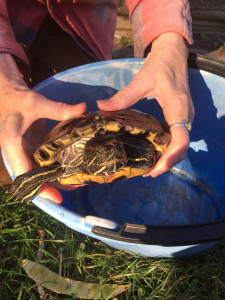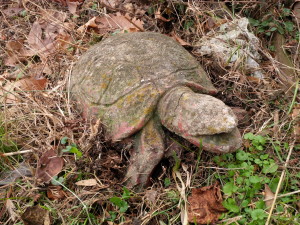Christine Schoenemann (Maccabee)
 Some things never change, and my love affair with turtles is one of them. This essay is about how a young girl looking for turtles in the woods grew into an eighteen-year-old carrying water turtles in a bucket on the Greyhound bus between home and college, to the me that I am now, in my sixties, still transporting them back and forth between their aquarium habitat and their outdoor pools.
Some things never change, and my love affair with turtles is one of them. This essay is about how a young girl looking for turtles in the woods grew into an eighteen-year-old carrying water turtles in a bucket on the Greyhound bus between home and college, to the me that I am now, in my sixties, still transporting them back and forth between their aquarium habitat and their outdoor pools.
As a child I was drawn like a magnet to the woods. Despite all my mother’s efforts to keep me from going there, I went anyway. At the time, I did not know that she was trying to protect me from any potential dangers lurking there. I only knew the woods to be a friendly place, full of wonder and mystery and turtles!
Before too long, my mother, Rose, a nature lover herself, gave up trying to stop me. She even permitted me to build a nice turtle town out of cinder blocks in our small backyard, south of Baltimore. Many years later, I was told by a neighbor boy that all the fellas didn’t know what to make of me, that I was a different sort of girl, but that they admired me. I wish I had known it then, as all they ever did was tease me!
So, at a very early age, I learned the joy of going off into the woods—with my dog as my sole companion—and digging in rich dirt under the leaves for worms as food for my turtles. I learned to love the healing smell of the woods in all seasons, and gave myself lessons in transplanting such things as the big-leaved, deep rooted, burdock to provide shade in the turtle pen. In short, I taught myself lessons in caring for creatures that no book could have taught me. I was learning by doing, and pretty much still am, though books can be a great source of information. I guess I was a hands-on person before the term was invented. Most importantly, since I had no computer or TV to distract me, my relationship with the natural world grew strong and, well, naturally. I count my blessings every day that I had such opportunities to explore and to learn, and feel sad that millions of children are not so fortunate.
I was about nine when I made my first Turtle Town. The most turtles I had at any one time was ten—eight box and two mud (they had their own private mud hole)—with only one male box turtle at a time. I learned the hard way not to have more than one male in my Turtle Town harem, for to see the flash of red eyes and the frothing at the mouth when two males fight over a female is enough to scare the pants off of anybody, especially a ten year old.
You might say I first learned about sex from my turtles, and I knew never to interfere with turtles when mating. Even then the males red eyes would flash fiercely and his mouth would froth. I always felt sorry for him as the hard shells made mating difficult, but usually successful, as I found several batches of eggs buried from a few of those awkward unions. One hot summer night, I watched as a female, ready to lay her eggs, laboriously dug her hole for hours, deep into the night. Fearing my flashlight was interfering with her progress, I reluctantly went inside the house by 11:00 p.m., having sacrificed watching the Miss America Pageant and having gained innumerable mosquito bites. In the morning, I excitedly ran outside to see if the eggs were laid, and sure enough, the ground was covered up as if it had never been touched.
There is nothing quite like holding a newly hatched baby turtle in your hand. It is so perfectly formed, it takes your breath away. A neighbor of mine a few houses over told me that she discovered eggs in her compost pile last spring, and when they hatched, she put one in the palm of her hand. It was only the size of a quarter and, “You could even feel its sharp little toenails against your skin!” she exclaimed. Such an amazing miracle of life, and so wonderful to know turtles are surviving and thriving in our little mountain valley, north of Thurmont.
I suppose lots of folks have their own turtle tales to tell. I just happen to have many—enough to write a book, actually. To end this particular chapter, however, I will tell you that one summer between college years, I freed all my box turtles, knowing I would not always be around to care for them. I remember the fear I had that some kid might find one and keep it in a cardboard box, confining it to a much worse prison than my own, and neglecting it until it sickened. But then again, this same kid might learn as I did how to care for turtles successfully and grow in respect for them as I had. These were my thoughts as I released my beloved turtle friends back into their home, back into the deep and friendly woods. I still had water turtles, which patiently endured trips in a bucket on the Greyhound; I only went about one year since then without a turtle. I have great respect for all turtles around the world, and so now comes the question Gloria Steinem suggests we ask: “What are we humans to ask the turtle?”
In my opinion, if turtles could speak, they would say: “Life on this planet is precious, a miracle, and not to be neglected. Take care of it for us.” This is the lesson my turtles taught me, and one I shall never forget.

 Christine Schoene Maccabee
Christine Schoene Maccabee